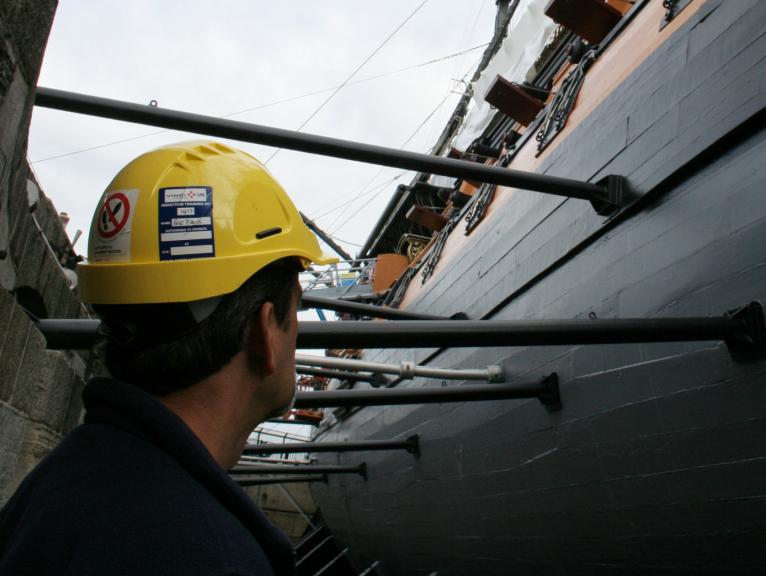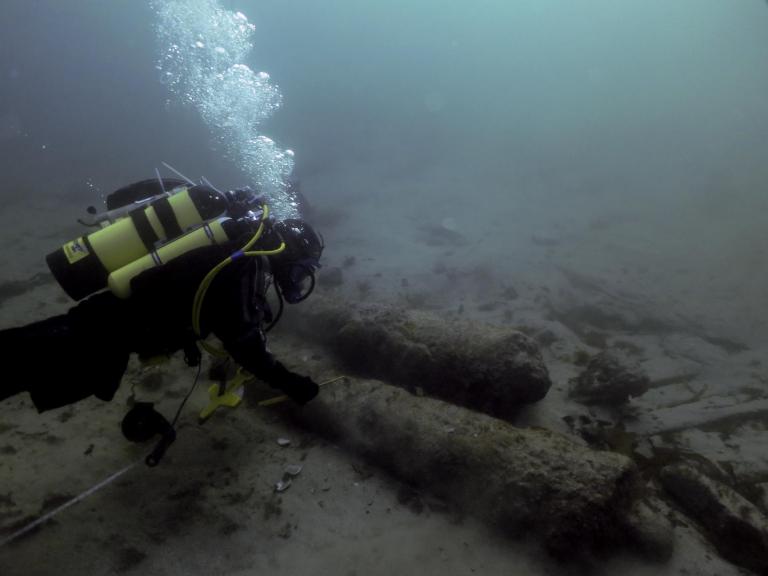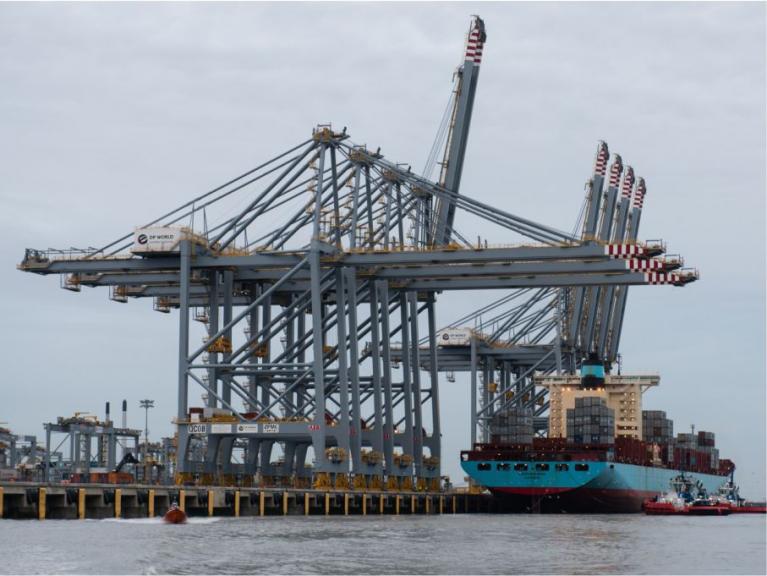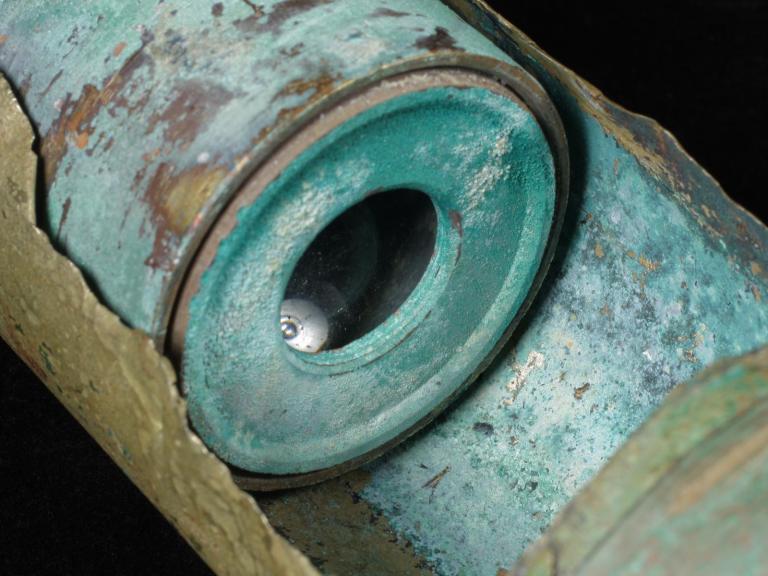50.700698117247, -0.96962928771973
Since 2002, Wessex Archaeology has been undertaking work on designated and undesignated marine heritage assets on behalf of Historic England (formerly English Heritage), Cadw, Department of hte Environment Northern Ireland and Historic Environment Scotland (formerly Historic Scotland).
This work has involved the archaeological assessment of many wreck sites, either to assess their significance as a precursor to possible scheduling, protection or designation, to undertake condition surveys or to re-assess sites. Advice was then provided to the client, based on non-statutory criteria, as to whether the asset met the criteria for designation or not, or whether some form of site management intervention was required.
The majority of the sites investigated were assessed against the criteria for the designation under the Protection of Wrecks Act (PWA)1973. Depending on the site, a recommendation to the MoD for protection under the Protection of Military Remains Act (PMRA) 1986 could also be made. A limited number of sites were assessed under the criteria for scheduling under the Ancient Monuments and Archaeological Areas Act (AMAA) 1979.



2002 - 2013 Protection of Wrecks Act Dive Contract
The work involved assessing sites in English, Welsh, Northern Irish and Scottish Waters. A vast range of wreck sites were investigated spanning the Bronze Age to the First World War. Designations were achieved based on advice provided by WA for a number of sites including the London (Thames Estuary), Iona II (Lundy), Campania (Firth of Forth) and the Thorness Bay Wreck (Solent), amongst others.
2013 - 2015 Heritage at Risk Dive Contract
In 2013, English Heritage (now Historic England) awarded Wessex Archaeology the Heritage at Risk – Designated Wrecks at Risk contract. The contract continued on the work previously undertaken under the Protection of Wrecks contract (2003−-2013), within English waters. With this project, Wessex Archaeology supported English Heritage’s role in relation to marine designation, and worked on both designated and undesignated marine sites. The project ran from January 2013 to the end of March 2015.
English Heritage selected a wide range of sites for investigation. Protected Wreck sites were selected for assessment of site stability and to determine if additional material had been exposed recently. Undesignated sites were identified through various sources, including the early ships and boats strategic designation programme, which developed from the ‘Early Boats and Ships (prehistory to 1840)’ desk based assessment. In addition, work contributed to the First World War submarine project, as part of the commemorations associated with the First World War.
Designations were achieved based on advice provided by Wessex Archaeology for a number of sites including the HMS Anglia (Dover Strait), the unknown Chesil Beach site and the German submarine U8 (English Channel).
2015 - 2017 Archaeological services in relation to Marine Protection Dive Contract
In 2015, Historic England commissioned Wessex Archaeology's Coastal & Marine team to undertake a two-year project to assess underwater sites: Archaeological Services in Relation to Marine Protection. Similar to the Heritage at Risk project, which ran from 2013−2015, Historic England selected sites of special interest in English Waters for archaeological investigation. Sites ranged from wreck sites identified through the Early Ships and Boats Project to First World War submarines. Other wreck sites selected for investigation had been identified by Wessex Archaeology during previous fieldwork. Still others were identified by the seabed explorations of the Shipwreck Project, a not-for-profit Community Interest Company based in Weymouth, that worked closely with Wessex Archaeology during the archaeological assessment of several sites.
The project aimed to archaeologically assess wreck sites on the seabed and intertidal area not only through intertidal walkover surveys, diver surveys and/or geophysical survey, but also through working with other organisations, and establishing links with local divers, dive groups and other stakeholders. Existing data, ranging from diver reports to listings in the National Record for the Historic Environment (NRHE), and from previous survey reports to recently acquired geophysical survey data were consulted and reviewed to inform fieldwork objectives.
The objectives for each site were site specific. However, in general, the site’s location was confirmed, material within the site investigated and accurately positioned, and the stability of the site assessed. From this, a record of each site was produced, including photographs, videos, site plans, and a detailed report.

2015−2018 Underwater Archaeology Services for Historic Environment Scotland
In 2015 Historic Environment Scotland (then Historic Scotland) contracted Wessex Archaeology's Coastal & Marine team to assess Scotland’s maritime heritage. The main aim was to have an archaeological unit for the investigation, recording, conservation, protection and promotion of significant underwater heritage assets, including those most at risk through neglect, decay or other threats in freshwater locations and in subtidal environments within Scottish territorial waters.
The main objectives of this contract depended on the sites chosen by Historic Environment Scotland. The contract set out to ensure the unit is capable to:
- Undertake specific surveys with other partner bodies;
- Carry out field assessments;
- Monitor designated assets and undertake remedial action; and
- Maintain and deliver an archive of primary data along with reports.
As part of the Scottish Underwater Archaeological Services contract, Wessex Archaeology worked on several sites from 2015 to 2017, including the Galmisdale Bay Wreck, the Kennemerland, the Belnahua slate quarry and Drottningen af Sverige (Queen of Sweden).
The chosen sites required a unique approach as each site was located in a different environment, including freshwater, intertidal and subtidal environments. The location of each site was confirmed and any visible material culture investigated and accurately positioned. A record of the sites was produced, including site plans, photographs, videos and a detailed report.
The sites in question were being evaluated prior to a decision to potentially designate the sites as an historic Marine Protected Area (MPA). The Kennemerland is now located within the Outer Skerries Historic MPA (HMPA5) and the Belnahua slate quarry is a scheduled monument (SM13216).
For more images from these projects visit our Flickr site here.



2017-2019 Archaeological Services in Relation to Marine Protection Dive Contract
In 2017, Historic England commissioned Wessex Archaeology’s Coastal & Marine team to continue to assess underwater sites and selected a range of sites of special interest in English Waters for archaeological investigations. Sites investigated in 2017 and 2018 included the following:
HMS Montagu
Work began with an undesignated site assessment on this pre-dreadnought battleship off Lundy, Devon followed by a diving fieldwork project. The fieldwork was undertaken by Coastal & Marine’s expert dive team in conjunction with six veteran service men and women as part of Marine Operation Nightingale, a ground-breaking military initiative run with Help for Heroes to use archaeology to support the recovery of wounded, injured and sick military personnel. The team surveyed various features from the wreck, including the probable shell hoist well and part of a 6 inch gun port. Protection was granted for the site in 2019.
Tankerton
In 2017 the team surveyed the intertidal site, working closely with a team of experts from the University of Wales Trinity Saint David and volunteers from Timescapes Kent. Work comprised a measured survey of the remains exposed in the intertidal area and the excavation of two evaluation trenches to ascertain the extent, state of preservation and character of the remains. Dendrochronological analysis of timbers recovered from the site suggested a felling date in the early 16th century, and the constructional details appeared consistent with a 16th or early 17th century sailing vessel. Work at Tankerton continued in 2018, with further excavation, and the site is now a Scheduled Monument.
A desk-based assessment reviewed the wrecks Seagull and Xanthe off Horsey Gap, Norfolk. The 19th century iron-built steamers illustrate the rapid development of steam technology in the 19th century and the adaptation of sailing cargo vessels to this new technology. Both the Seagull and Xanthe sites were protected in 2019.
Other work in 2017-2018 focused on a number of sites in the Thames.



2019-2021 Archaeological Services in Relation to Marine Protection Dive Contract
In 2019, Historic England commissioned Wessex Archaeology’s Coastal & Marine team to continue to assess underwater sites. The team examined a wide variety of sites, and here are a few examples of the work undertaken:
The team undertook an assessment of two sunken American Landing Ship Tanks (LSTs) that were lost in Lyme Bay off the Dorset and Devon coast in Exercise Tiger, a practice for D-Day in the spring of 1944. The work was part of Historic England’s commemoration of the 75th anniversary of D-Day.
The Coastal & Marine team worked closely with Historic England, the Ministry of Defence, local historians and divers to investigate the remains of LST 507 and LST 531, lost during the exercise when they were ambushed by a force of German E-boats. The archaeological investigation of the sites was designed with sensitivity, to ensure that the last resting place of the sailors lost on board these wrecks would not be disturbed. Work was undertaken with Vocean’s Falcon ROV, which provided sonar images and videos of the site.



To examine UB 30, a submarine lost off Whitby, Wessex Archaeology’s ROV pilots utilised our in-house ROV to inspect the wreck at a depth of 50 m. The work was undertaken as part of Historic England’s themed research on the war at sea during the First World War.



The ROV was also the survey method of choice for the South Australian, a 19th century merchant clipper, that Wessex Archaeology assessed with the help of Devon wreck investigator Keith Denby. The wreck is at a depth of 40 – 50 m, and the ROV allowed archaeologists to survey the site for longer and at a lower cost.

2019-2021 Underwater Archaeology Services for Historic Environment Scotland
Following the 2015-2019 Underwater Archaeology Services contract for Historic Environment Scotland, Wessex Archaeology was again awarded the contract for the period 2019-2021.
In summer 2019 work under the contract began with a condition survey of the wreck in the Kinlochbervie Historic Marine Protected Area. This wreck was likely to have been a merchant ship, probably originating from the Iberian peninsula, lost during the 1590s or slightly after 1600. The wreck was surveyed using Wessex Archaeology’s ROV and photogrammetry models were created of the wreck site.







